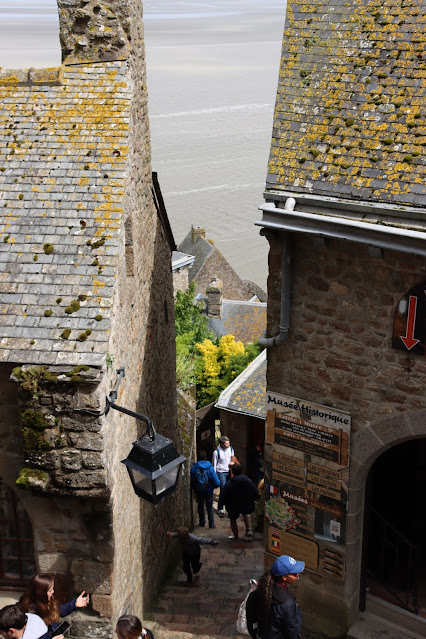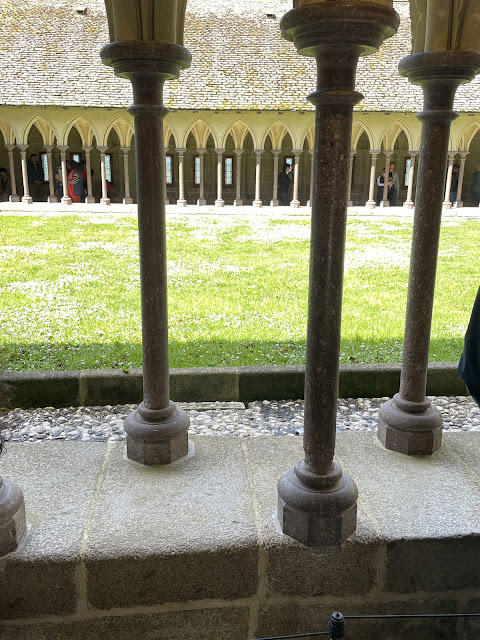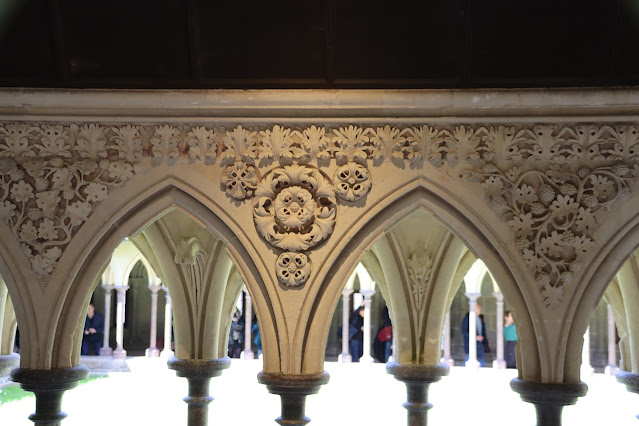When I suggested that we could visit Mont Saint Michel, Tomas was quite excited. Much more excited than I expected him to be when we were discussing visiting an old abbey on an island. It turns out that one of the games he plays, Sniper Elite 5, had a Mont Saint Michel level and he was excited to see it for real:
 |
| "Spy Academy" level from Sniper Elite 5 |
Before we headed to the Mont, Tomas also had another request - just off the coast of France were the Channel islands of Jersey and Guernsey - also levels he had played in Sniper Elite. We drove to the shore line as close to the islands as we could get, and despite the weather we were just able to see the island of Jersey:

The island of Mont Saint Michel is accessible at low tide by land, but at high tide it was only accessible by boat or bridge. The island was never taken by the English during the Hundred Years' War - being easily defendable and protected by the tides. The difference in water level between high and low tide is around 14m.
The stories say that the Abbey was built after Aubert of Avranches (the bishop of Avranches) was visited by the Archangel Michael and told to build an abbey on Mont Tombe. Aubert doubted the vision so ignored it. Michael appeared a second time and Aubert ignored him again, worried that the vision was a demonic visitation.
The Archangel, not used to being ignored, appeared a third time and touched Aubert on the head and ordered him to built the abbey. This time Aubert listened and the abbey was dedicated on 16th October 709. The angelic touch left Aubert with a hole in his skull (some less religious scholars believe this was due to a trepanation - an old medieval technique of drilling into the skull to alleviate pressure and headaches). Either way, the lesson here is don't mess with angels.
 |
| Aubert's Skull - Held in Saint-Gervais Basilica as a relic |
The island was yielded to the Bretons in 867, and recaptured by William I Longsword in 933. In the Hundred Years War, the English sieged the abbey in 1423 and again in 1433 but failed to take it against a much smaller French garrison.
The abbey became a major site of pilgrimage, with pilgrims travelling from all over Europe to visit the abbey. During the French Revolution it was used as a prison, which was closed in 1863 when the site was deemed a historic architectural treasure.
During the occupation in WW II the Germans used Mont Saint Michel as a lookout and tourist site.
Driving up to Mont Saint Michel was impressive - it was visible over the flat landscape from quite a distance:
The car park for the island was recently moved to be about 3 kilometres from the island itself to protect the area from damage. A hydraulic dam was also used to drain the silt build up around the island and the causeway was raised to help restore the area.
There were two options from the car park - either a bus or a walk over the bridge. Since the bus had just arrived and there was not much crowd, we decided to take the bus there and walk back.
The bus dropped us off near the end of the causeway, with a great view of the Mont.
We had about an hour until our tour time for the abbey, so we decided to start making our way through the entrance and into the town:
as we moved further inside, the streets narrows and got a lot more busy:
Cameron noticed a very narrow stairway away from the main road and we followed it up:


This lead us to a viewing area about a third of the way up:
then we were on our way back up again:
Eventually we came to the base of the abbey and had about 30minutes to explore and checkout the views before we headed up to our tour:
The path up the abbey was pretty crowded, but we had prepaid tickets so we made our way up, got our audio headsets and waited for our tour.
 |
| The mould of Saint Michael slaying the dragon - that was used to form the golden statue on the top of the spire. |
I found an interesting audio guide transcript here - we had an actual guide, but if you are interested there are more details in the audio guide
here.
Our first stop was inside the abbey itself. Our guide explained that the abbey was a major site of pilgrimage and the pilgrims would brave the rising tides, quicksand and other dangers in order to approach the abbey. When they arrived they were greeted by the high walls atop the higher cliffs - quite an imposing sight. The granite used to build the abbey was mined on the Channel Islands (Jersey and Guernsey) and shipped to the island.
 |
| Sculpting of a pilgrim with a horn used to signify arrivals |
 |
| The golden Saint Michael |
Similar to the Lund Cathedral the inside walls were made of limestone which had changed to a reddish-pink colour when exposed to fire. When the abbey had been used as a prison there was a large fire in a workshop used to produce straw hats. This (along with some earlier fires) led to the distinctive colouring of some of the inside walls:
 |
| Wooden roof structure |
We then headed outside and into the cloister (Merveille). Due the available space (Mont Saint Michel is built in a pyramid shape and this is on the upper part), the garden is a trapezoid instead of a more standard rectangle. It is surrounded by 137 columns completed with sculptures made from the malleable Caen stone.
Our next stop was the rectory, where the monks took their meals. The room was designed so that the windows were hidden from the angles but would still let in light:
 |
| Cam said this was a Hidden Mickey |
Next stop was downstairs, past a carving of Archangel Michael burning a hole through the skull of... I mean providing a vision to Bishop
Aubert. It had original sat at the entrance to the abbey and the face of the archangel was destroyed during the Commune of Paris in 1870:
Next stop was the Guest Hall - used to house the important visitors to the Abbey. It consisted kitchen and the great hall - these would originally have been separated by a curtain. The fireplaces were enormous!:
The nobles in the great hall also had access to a private chapel and shrine for their own prayers - known as the Chapel Magdalena:
Our next stop was the Crypt of Great Pillars. Directly underneath the abbey church, the giant pillars were built after the Romanesque choir had collapsed in 1421. The giant pillars actually encase smaller pillars, and provide support for the weight of the abbey above. The pillars are 5m in diameter, and the floor is marked with a number of mosaics. The room was originally used for storage and as a wine cellar.
Our next stop was the St Martin Crypt - one of the oldest chapels in the abbey:
Next was the Monk's Ossuary - This room was dominated by a large wooden wheel that was built in the 1800s to lift food and water to the inmates of the prison. To the side of the wheel is a deep hole - the monk's ossuary. Since there was not sufficient room to bury the monks in the cemetery (only the abbots), their bodies were dropped down the hole and covered with quicklime.
Just beyond the ossuary was Saint Etienne Chapel. This chapel was used as the chapel, deliberately situated between the infirmary and the ossuary.
We then walked through the covered walkway and towards the Knights Hall or Scriptorium. These halls were used for the scribes to stretch their legs and have a break from the work of creating the books and scrolls:
The final room was the scriptorium, Known as the Knight's Hall - named because of the Knights Saint-Michel, who is was originally believed may have met in this hall. This was later believed to be incorrect and that this was actually the scriptorium of the abbey.
We then headed outside and started on our way back down to the shore:
We then walked back across the causeway to the car, taking a few parting shots of the abbey as we went:
Just outside of the carpark we were stopped for about 10 minutes while a huge number of sheep were transported down the main road of the small town:



















































































































































No comments:
Post a Comment